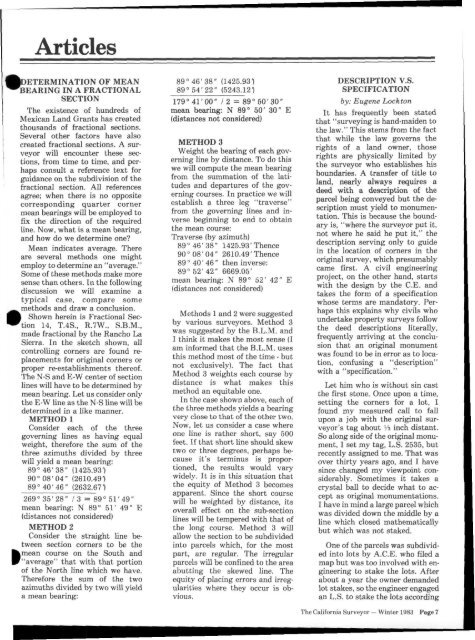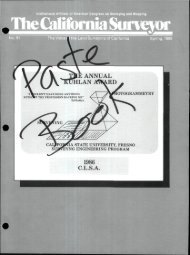No. 70 The Voice of the Land Surveyors of Califo rnia Winter ... - CLSA
No. 70 The Voice of the Land Surveyors of Califo rnia Winter ... - CLSA
No. 70 The Voice of the Land Surveyors of Califo rnia Winter ... - CLSA
You also want an ePaper? Increase the reach of your titles
YUMPU automatically turns print PDFs into web optimized ePapers that Google loves.
Articles<br />
ETERMINATION OF MEAN<br />
BEARING IN A FRACTIONAL<br />
SECTION<br />
<strong>The</strong> existence <strong>of</strong> hundreds <strong>of</strong><br />
Mexican <strong>Land</strong> Grants has created<br />
thousands <strong>of</strong> fractional sections.<br />
Several o<strong>the</strong>r factors have also<br />
created fractional sections. A surveyor<br />
will encounter <strong>the</strong>se sections,<br />
from time to time, and perhaps<br />
consult a reference text for<br />
guidance on <strong>the</strong> subdivision <strong>of</strong> <strong>the</strong><br />
fractional section. All references<br />
agree; when <strong>the</strong>re is no opposite<br />
corresponding quarter corner<br />
mean bearings will be employed to<br />
fix <strong>the</strong> direction <strong>of</strong> <strong>the</strong> required<br />
line. <strong>No</strong>w, what is a mean bearing,<br />
and how do we determine one?<br />
Mean indicates average. <strong>The</strong>re<br />
are several methods one might<br />
employ to determine an "average."<br />
Some <strong>of</strong> <strong>the</strong>se methods make more<br />
sense than o<strong>the</strong>rs. In <strong>the</strong> following<br />
discussion we will examine a<br />
typical case, compare some<br />
methods and draw a conclusion.<br />
Shown herein is Fractional Section<br />
14, T.4S., R.7W., S.B.M.,<br />
made fractional by <strong>the</strong> Rancho La<br />
Sierra. In <strong>the</strong> sketch shown, all<br />
controlling corners are found replacements<br />
for original corners or<br />
proper re-establishments <strong>the</strong>re<strong>of</strong>.<br />
<strong>The</strong> N-S and E-W center <strong>of</strong> section<br />
lines will have to be determined by<br />
mean bearing. Let us consider only<br />
<strong>the</strong> E-W line as <strong>the</strong> N-S Hne will be<br />
determined in a like manner.<br />
METHOD 1<br />
Consider each <strong>of</strong> <strong>the</strong> three<br />
governing lines as having equal<br />
weight, <strong>the</strong>refore <strong>the</strong> sum <strong>of</strong> <strong>the</strong><br />
three azimuths divided by three<br />
will yield a mean bearing:<br />
89° 46'38" (1425.93')<br />
90° 08'04" (2610.49')<br />
89° 40'46" (2632.67')<br />
269°35'28" /3 = 89°51'49"<br />
mean bearing: N 89° 51' 49" E<br />
(distances not considered)<br />
METHOD 2<br />
Consider <strong>the</strong> straight line between<br />
section corners to be <strong>the</strong><br />
I mean course on <strong>the</strong> South and<br />
'"average" that with that portion<br />
<strong>of</strong> <strong>the</strong> <strong>No</strong>rth line which we have.<br />
<strong>The</strong>refore <strong>the</strong> sum <strong>of</strong> <strong>the</strong> two<br />
azimuths divided by two will yield<br />
a mean bearing:<br />
89° 46'38" (1425.93')<br />
89° 54'22" (5243.12')<br />
179°41'00" /2 = 89°50'30"<br />
mean bearing: N 89° 50' 30" E<br />
(distances not considered)<br />
METHOD 3<br />
Weight <strong>the</strong> bearing <strong>of</strong> each governing<br />
line by distance. To do this<br />
we will compute <strong>the</strong> mean bearing<br />
from <strong>the</strong> summation <strong>of</strong> <strong>the</strong> latitudes<br />
and departures <strong>of</strong> <strong>the</strong> governing<br />
courses. In practice we will<br />
establish a three leg "traverse"<br />
from <strong>the</strong> governing lines and inverse<br />
beginning to end to obtain<br />
<strong>the</strong> mean course;<br />
Traverse (by azimuth)<br />
89° 46'38" 1425.93'<strong>The</strong>nce<br />
90° 08'04" 2610.49'<strong>The</strong>nce<br />
89° 40'46" <strong>the</strong>n inverse:<br />
89° 52'42" 6669.05'<br />
mean bearing: N 89° 52' 42" E<br />
(distances not considered)<br />
Methods 1 and 2 were suggested<br />
by various surveyors. Method 3<br />
was suggested by <strong>the</strong> B.L.M. and<br />
I think it makes <strong>the</strong> most sense (I<br />
am informed that <strong>the</strong> B.L.M. uses<br />
this method most <strong>of</strong> <strong>the</strong> time - but<br />
not exclusively). <strong>The</strong> fact that<br />
Method 3 weights each course by<br />
distance is what makes this<br />
method an equitable one.<br />
In <strong>the</strong> case shown above, each <strong>of</strong><br />
<strong>the</strong> three methods yields a bearing<br />
very close to that <strong>of</strong> <strong>the</strong> o<strong>the</strong>r two.<br />
<strong>No</strong>w, let us consider a case where<br />
one line is ra<strong>the</strong>r short, say 500<br />
feet. If that short Une should skew<br />
two or three degrees, perhaps because<br />
it's terminus is proportioned,<br />
<strong>the</strong> results would vary<br />
widely. It is in this situation that<br />
<strong>the</strong> equity <strong>of</strong> Method 3 becomes<br />
apparent. Since <strong>the</strong> short course<br />
will be weighted by distance, its<br />
overall effect on <strong>the</strong> sub-section<br />
lines will be tempered with that <strong>of</strong><br />
<strong>the</strong> long course. Method 3 will<br />
allow <strong>the</strong> section to be subdivided<br />
into parcels which, for <strong>the</strong> most<br />
part, are regular. <strong>The</strong> irregular<br />
parcels will be confined to <strong>the</strong> area<br />
abutting <strong>the</strong> skewed hne. <strong>The</strong><br />
equity <strong>of</strong> placing errors and irregularities<br />
where <strong>the</strong>y occur is obvious.<br />
DESCRIPTION V.S.<br />
SPECIFICATION<br />
by: Eugene Lock ton<br />
It has frequently been stated<br />
that "surveying is hand-maiden to<br />
<strong>the</strong> law." This stems from <strong>the</strong> fact<br />
that while <strong>the</strong> law governs <strong>the</strong><br />
rights <strong>of</strong> a land owner, those<br />
rights are physically hmited by<br />
<strong>the</strong> surveyor who estabUshes his<br />
boundaries. A transfer <strong>of</strong> title to<br />
land, nearly tdways requires a<br />
deed with a description <strong>of</strong> <strong>the</strong><br />
parcel being conveyed but <strong>the</strong> description<br />
must yield to monumentation.<br />
This is because <strong>the</strong> boundary<br />
is, "where <strong>the</strong> surveyor put it,<br />
not where he said he put it," <strong>the</strong><br />
description serving only to guide<br />
in <strong>the</strong> location <strong>of</strong> corners in <strong>the</strong><br />
original survey, which presumably<br />
came first. A civil engineering<br />
project, on <strong>the</strong> o<strong>the</strong>r hand, starts<br />
with <strong>the</strong> design by <strong>the</strong> C.E. and<br />
takes <strong>the</strong> form <strong>of</strong> a specification<br />
whose terms are mandatory. Perhaps<br />
this explains why civils who<br />
undertake property surveys follow<br />
<strong>the</strong> deed descriptions literally,<br />
frequently arriving at <strong>the</strong> conclusion<br />
that an original monument<br />
was found to be in error as to location,<br />
confusing a "description"<br />
with a "specification."<br />
Let him who is without sin cast<br />
<strong>the</strong> first stone. Once upon a time,<br />
setting <strong>the</strong> corners for a lot, I<br />
found my measured call to fall<br />
upon a job with <strong>the</strong> original surveyor's<br />
tag about V2 inch distant.<br />
So along side <strong>of</strong> <strong>the</strong> original monument,<br />
I set my tag, L.S. 2535, but<br />
recently assigned to me. That was<br />
over thirty years ago, and I have<br />
since changed my viewpoint considerably.<br />
Sometimes it takes a<br />
crystal ball to decide what to accept<br />
as original monumentations.<br />
I have in mind a large parcel which<br />
was divided down <strong>the</strong> middle by a<br />
line which closed ma<strong>the</strong>matically<br />
but which was not staked.<br />
One <strong>of</strong> <strong>the</strong> parcels was subdivided<br />
into lots by A.C.E. who filed a<br />
map but was too involved with engineering<br />
to stake <strong>the</strong> lots. After<br />
about a year <strong>the</strong> owner demanded<br />
lot stakes, so <strong>the</strong> engineer engaged<br />
an L.S. to stake <strong>the</strong> lots according<br />
<strong>The</strong> <strong>Califo</strong><strong>rnia</strong> Surveyor - <strong>Winter</strong> 1983 Page 7
















